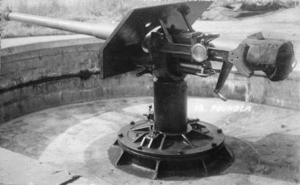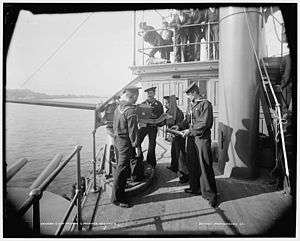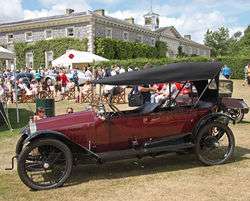Driggs-Seabury
Driggs-Seabury Ordnance Company was founded in 1897 by William H. Driggs and Samuel Seabury, both US Navy officers, in partnership with Louis Labodie Driggs, originally to produce guns for the US Army and US Navy designed by the partners. After a few reorganizations and an entry into the motor vehicle market, the company reorganized again in 1925; its ultimate fate is unclear from references.[1]
| Industry | Artillery, Automotive |
|---|---|
| Founded | circa 1898 |
| Founder |
|
| Headquarters |
|
Key people |
|
| Products | Naval artillery, Army artillery, motor vehicles |
History
Driggs-Seabury was preceded by the Driggs-Schroeder series of weapons, designed by W. H. Driggs and Seaton Schroeder in the late 1880s and produced by the American Ordnance Company in the 1890s. Driggs-Seabury incorporated the former Seabury Gun Company at its founding. Driggs-Seabury's plant was initially in Derby, Connecticut, in the former Brady Manufacturing facility.[2] Although Seabury died in 1902, followed by Driggs in 1908, the company continued under the leadership of Louis Labodie "L. L." Driggs until 1925. The relationship, if any, between William H. Driggs and Louis "L. L." Driggs is unclear; L. L. Driggs was formerly with the American Ordnance Company, manufacturer of Driggs-Schroeder weapons.[2] The company moved production to Sharon, Pennsylvania in 1904; the US Rapid Fire Gun and Power Co. acquired the plant in Derby.[2] The company manufactured motor vehicles 1913–15 and 1921–25, but sold its weapons production and plant in Sharon to Savage Arms in a 1915 merger.[3][4][5][6] Under Savage Arms, the Sharon plant made Lewis guns in World War I. A probably related "Driggs Ordnance Company" existed in 1917.[7] Dropping the Seabury name, Driggs was reconstituted as a motor vehicle manufacturer in New Haven, Connecticut in 1921, confusingly named "Driggs Ordnance & Manufacturing Corporation". Driggs was reorganized out of receivership as "Driggs Ordnance and Engineering" in 1925.
Weapons


Weapons produced by Driggs-Seabury included:
- 3-inch gun M1898 (a.k.a. 15-pounder),[8] a coast defense weapon for the Army on a retractable "masking parapet" carriage, also made by Driggs-Seabury. 120 guns and carriages were built. The weapon's barrel was later used as the basis for the 3-inch Gun M1918, an anti-aircraft weapon. Possibly due to the bankruptcy of Driggs-Seabury, the M1898 seacoast weapons were removed from service in the early 1920s.[9]
- US Navy 3"/23 caliber gun Mark 13 during World War I. This had a semi-automatic horizontal sliding breech block. In this case semi-automatic means the breech opens and the cartridge case is ejected on firing, ready for the next round to be loaded manually.[10]
- The Navy 6-pounder Mark 11 and 3-pounder Mark 14 were made by Driggs-Seabury.[11]
- Two 6-pounder (57 mm (2.24 in)) Driggs-Seabury guns were adopted by the US Army and designated the M1898 and M1900. Twenty M1898 and forty M1900 weapons were procured. Seventeen of the M1898 weapons were used on troop transports in the Spanish–American War.[12] For land service, the 6-pounders were on "parapet" or "rampart" mounts which allowed a wheeled carriage to be fixed to a pintle mount.[13] Some of these weapons were used at coastal forts in limited quantities beginning circa 1900, usually two per fort, and 12 were at Fort Ruger, Oahu, Hawaii 1915-19 under the Land Defense Project, which also included guns in the Philippines.[13][14] (The Marks II and III Driggs-Seabury weapons mentioned in some sources are actually earlier Driggs-Schroeder weapons manufactured by American Ordnance, possibly similar to the Navy Marks 6 and 8.)[15][11])
- A 3.2-inch field gun was featured in Scientific American in 1898, possibly an unsuccessful bid and possibly related to a Driggs-Schroeder "limited recoil" carriage for the 3.2-inch gun M1890, submitted to the US Army in 1895. It was not adopted by the US Army.[16][17][18]
- The breech mechanism for the US Navy 3"/50 caliber gun Mark 5.[19]
Vehicles
The vehicles produced by Driggs-Seabury and Driggs (some of which were other manufacturers' designs) included:

- 1913 Twombly cyclecar, a small two-seat automobile. Cyclecars were small, inexpensive vehicles that were popular 1910-29.[20]
- 1915 Vulcan Power Wagon truck, rated at three to seven tons depending on model.[21][22]
- 1921 Driggs Model D, a coupe.[23]
- 1923 Driggs taxicab, a version of the Model D built for the Diamond Taxicab Company of New York City. Another successful bidder was Elcar, and an unsuccessful one was Ace.[24]
Other products
Driggs Ordnance Company advertised a boat engine designed for quiet operation in 1917.[7]
References
- Patent assigned by William Hale Driggs in 1906 to Driggs-Seabury Ordnance Corp.
- Williford, p. 222
- Poor’s Manual of Industrials, 1916, Vol. 7, New York: Redmond & Co., pp. 1722-1726
- Unofficial Savage Arms company history
- "Official Savage Arms company history". Archived from the original on 2015-04-03. Retrieved 2015-03-28.
- Official Savage Arms history outline
- "Speed with Silence" advertisement, Power Boating magazine, July 1917, p. 7
- Lohrer, George L. Ordnance Supply Manual, U. S. Ordnance Dept., Washington: Government Printing Office, 1904, pp. 295-300
- Berhow, Mark A., Ed. (2004). American Seacoast Defenses, A Reference Guide, Second Edition. CDSG Press. pp. 70–71, 200–228. ISBN 0-9748167-0-1.
- DiGiulian, Tony 3"/23 gun at Navweaps.com
- Campbell, p. 147
- Lohrer, George L. Ordnance Supply Manual, U. S. Ordnance Dept., Washington: Government Printing Office, 1904, pp. 282-295
- Berhow, pp. 188-189
- Williford, pp. 44-45
- DiGiulian, Tony US 6-pounder guns Mks 1-13
- Blueprint for a Driggs-Schroeder 3.2-inch gun from Winchester Repeating Arms Company, at the Buffalo Bill Center of the West
- Scientific American, Vol. 79, Issue 6, article on the 3.2-inch Driggs-Seabury field gun
- Ordnance Corps, US Army (1896). Annual Report of the Chief of Ordnance, Field Material section. Washington: Government Printing Office. p. 53.
- DiGiulian, Tony, 3-inch gun Marks 2, 3, 5, 6, and 8 at Navweaps.com
- Twombly cyclecar description Archived copy
- Hemmings Motor News, December 2011
- Vulcan Power Wagon article, 1912
- History of Early American Automobile Industry, 1921, Ch. 29, Section “Driggs” (from Motor Age magazine)
- "Diamond Cab built by Driggs Company", Automotive Industries magazine, 5 October 1922
- Campbell, John (1985). Naval Weapons of World War Two. Annapolis: Naval Institute Press. ISBN 0-87021-459-4.
- Williford, Glen M. (2016). American Breechloading Mobile Artillery, 1875-1953. Atglen, Pennsylvania: Schiffer Publishing. ISBN 978-0-7643-5049-8.
External links
- William H. Driggs entry at arlingtoncemetery.net
- Patent for a breech-loading cannon by Samuel Seabury, patented 20 February 1894
- US Naval Academy seamanship textbook by Rear Admiral Stephen B. Luce, with Samuel Seabury as a co-author
- Obituary of Samuel Seabury, The New York Times 1 June 1902
- Photo of 1921 Driggs Model D roadster